10 Small Changes for Big Workplace Wins

Most offices are stuck in a state of post-pandemic limbo. Too many or too few desks. Out-of-touch executive mandates or an altogether lack of structure. People coming in, unsure if anyone else will be there or if they’ll have to fight to find an open desk. Let’s be real, it’s a bit of a mess.
But we have some good news. You don’t need a full office redesign to fix it.
The biggest workplace wins often come from the smallest changes. From simplifying desk booking to making meetings actually easier to host, here are 10 simple (budget friendly) ways to turn your office into a place people actually want to be.

1. Rethink Desk Setup to Support Habits, Not Just Headcount
What to Change: Not everyone needs a permanent desk, but a free-for-all can discourage office attendance, even for the most avid office-goer. Designate shared assigned desks for hybrid regulars and offer priority desk booking for frequent in-office employees.
Workplace Impact: A little structure goes a long way in building office habits that stick. You’ll reduce daily uncertainty, which is one of the top complaints in hybrid offices. Employees can walk in knowing where they’ll sit and who they’ll be near. Where people feel the difference? More predictable schedules, less desk drama, and smoother office days.
2. Create Neighborhoods, Foster Collaboration, Avoid Chaos
What to Change: Group teams, departments, or cross-functional pods into designated zones. It’s an easy layout shift that makes a big difference in how people interact in the office. Don’t overthink the floor plan, just prioritize giving people a space to thrive.
Workplace Impact: This small change improves team visibility and encourages quick syncs that don’t need a meeting invite. It brings structure to a sometimes unpredictable hybrid routine and fosters connectivity within teams.
3. Add Visibility to “Who’s In," Including Visitors
What to Change: Show who’s coming into the office directly in tools employees already use, like Outlook or Google Calendar. Tie in visitor registration, check-in, and badge printing so the front desk is just as seamless. Keep everything visible, all in one place.
Workplace Impact: Employees are more likely to show up when they know who else will be there. Visitors get a smoother welcome experience, and workplace teams spend less time coordinating or chasing down missed connections.

4. Work with AI to Make More Informed Decisions Quickly
What to Change: Use AI to identify patterns in space usage and surface recommendations for layouts, policies, or booking behaviors. Instead of spending hours sorting through data, automate the analysis and solve your workplace problems simply by asking a few questions.
Workplace Impact: No more second-guessing floorplans or gut-checking policies. You’ll adapt faster, reduce friction, and make confident decisions grounded in real behavior that’s backed by data.
5. Give Office Managers a Single Workplace Dashboard
What to Change: Centralize your workplace ops functions into one place. Think meeting support, delivery tracking, tech issues, room status, and more, all in one view.
Workplace Impact: Admins get time back, chaos gets dialed down, and the office actually feels manageable. When operations run on a single system, nothing slips through the cracks.
6. Make Meeting Services Part of the Calendar Flow
What to Change: Let employees request catering, AV, and room setups at the same time they book a meeting. Fully-integrated, in one place. The goal? Fewer emails, fewer disjointed tools, and zero “did anyone order coffee?” moments.
Workplace Impact: Meetings feel more polished and less reactive. Employees get what they need without chasing it down, and workplace teams stay ahead of logistics without playing catch-up.

7. Let Space Data Guide Your Next Space Cut or Expansion
What to Change: Use space planning and usage data to spot which areas are thriving and which are wasted square footage (and rent spend). It’s time for the guessing game to end. Make changes based on what’s actually happening in your office.
Workplace Impact: You’ll make smarter real estate decisions that match how your office is truly being used. That means fewer empty zones, better investment in high-traffic areas, and real ROI from your entire floor plan.
8. Track Policy Adherence Without Micromanaging
What to Change: Use data like badge swipes or Wi-Fi connections to see who’s in the office and when. Avoid the awkward “Did you come in today?” email altogether.
Workplace Impact: Leaders get the visibility they need without piling on admin tasks for employees. You’ll spot trends, understand attendance patterns, and keep return-to-office conversations rooted in data, not assumptions.
9. Build Trust with Micro-feedback Loops
What to Change: Make it easy for employees to share quick, low-effort feedback about the office. Add simple prompts like “How was your meeting room today?” or “Was your desk clean?” directly into the platforms people already use. Think emojis, 1–5 ratings, or one-click polls that take less than a second to answer.
Workplace Impact: You’ll catch what is and isn’t working before it becomes a bigger issue. This kind of fast feedback helps you improve the office in real time, not just at review time. And it shows employees you’re listening, which builds trust and encourages them to speak up again.
10. In-Office “Nudges” That Build Culture
What to Change: Introduce small rituals that give employees a reason to engage beyond assignments, tasks, and meetings. It could be rotating playlists, desk-side leadership drop-ins, or a weekly question posted at the coffee station. The key is consistency, not scale.
Workplace Impact: These small cues send a big message: the office isn’t just functional, it’s intentional. They build routine, create moments of connection, and give people a reason to feel like they belong when they show up.

Give Your Office Space A Refresh
These aren’t massive infrastructure projects. They’re smart, straightforward moves that solve real problems.
Whether you implement one or all ten, the goal is the same: make the workplace easier to use and easier to manage. Because hybrid work doesn’t have to be chaotic. It can be intentional, data-driven, and, when done correctly, optimize office ROI.













